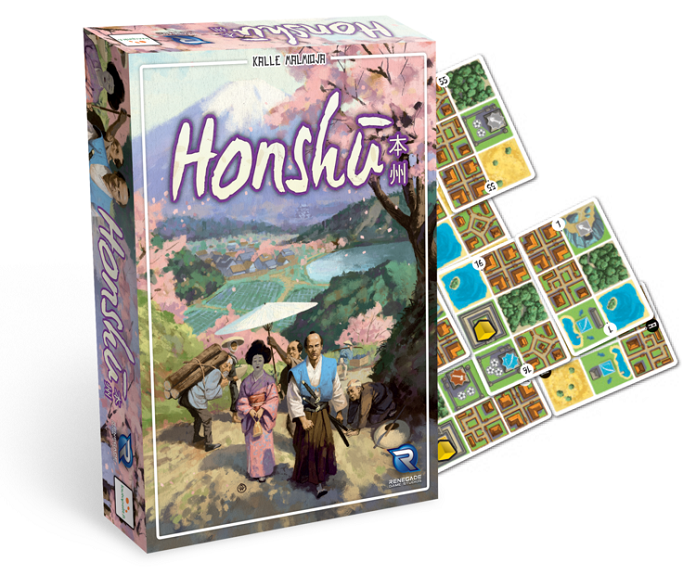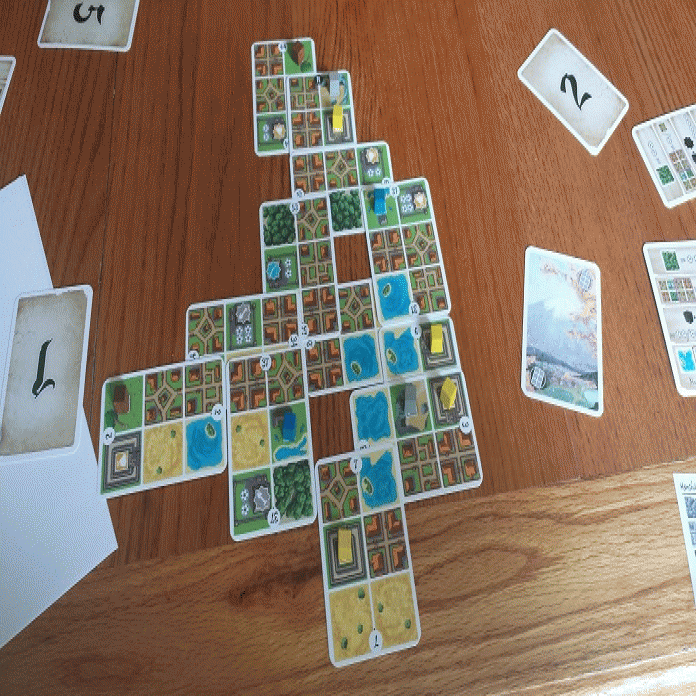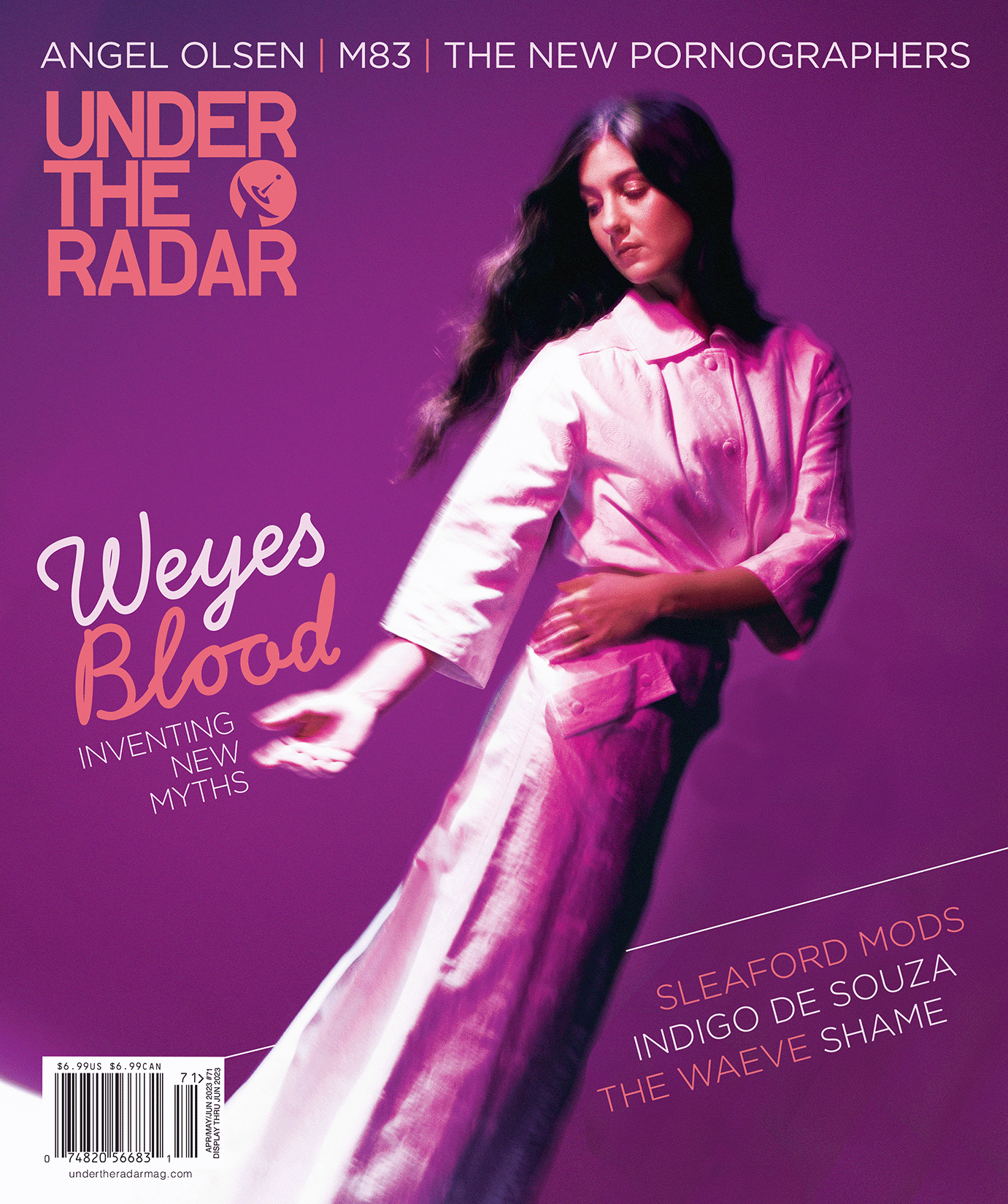
The PLAYlist 09: Honshu
Thanks to reviewing Yokohama, Hanamikoji, and now Honshu, I know a great deal more about the geography of Japan than I did six months ago. One of the latest titles to find inspiration in the land of the rising sun, Honshu, is named after the largest island of Japan, which is home to Tokyo, Kyoto, Osaka, Hiroshima, and many more of the nation’s biggest hubs. (In fact, more than 80% of Japan’s population lives on Honshu.) The game is set during Japan’s famed feudal era, when the nation underwent numerous periods of cultural and economic prosperity. You play as the leader of one of Japan’s noble families as you set out to expand your holdings across the land.
In gaming, there are few joys as consistently satisfying as watching a miniature empire spread before your very eyes. That’s why a game like Carcassonne – the big kahuna of games which start out tiny and then rapidly consume an entire table – remains a perennial favorite in the community, and one that regularly serves as a newcomer’s gateway into the hobby. Honshu scratches a similar itch, plays in under half an hour, and mixes in a fun bidding aspect that allows for gentle subterfuge. Plus, it comes in a teeny-weeny box that makes it as portable as you average Stephen King paperback. In all of those respects, Honshu is a game that we’ll recommend across the board to both casual and less-than-casual gamers. For more detailed reasons why, read on, you handsome devils, read on.
Each player starts the game with one random, fledgling city card on the table in front of them and a hand of six additional cards. Every card is divided into six squares. These squares each represent one of the game’s five various land types: city, desert, lake, resource (quarry, fishing hole, etc.), or factory. What you’ll be doing is laying these cards down in front of you to build on to your personal map, with at least one square of each card you add overlapping (or being overlapped by) a card that was already on the table. At the end of the game, points will be scored according to how many of each various land type you have in your personal Japanese wonderland. These lands vary in how they’re scored, but more on that momentarily…
You see, there’s a sexy wrinkle in how you select which cards make their way into your empire. It’s not as simple as putting a card from your hand onto the table – no, no, no no no. No. Each round (of which there are 12) starts with a session of blind bidding followed by drafting.
“Bidding and drafting?” Yes! Each card has a number value listed on it. Players toss one face-down from their hands into the center of the table; these are flipped simultaneously, and the player who threw in the highest-numbered card gets first pick of any of the cards just flipped. (Second-highest goes next, then third-highest, and so on.) You don’t have to take your own card, so if somebody else tossed in something that better fits your game plan, well, help yourself. No one’s judging. Once everyone has a card, you place them somewhere in your personal village area and then start the whole bidding process over again. (In a two-player game, it’s a little different: players select a pair of cards from the ones they revealed, or from two drawn at random from a neutral deck.)
This mechanic separates Honshu from something like, say, Carcassonne, because it takes quite a bit of the randomness out of what you’re given to work with. Unless you’re the last player picking in a round, you’ve always got some choice in what card you’ll add to your town. (And there are no “bad” cards – even if you’re not dealt the card you’re hoping for, you can pivot to a new strategy and stay competitive.) There’s a lot of thought to be put into which cards you’ll toss into the bidding and when. After the third round, you pass your hands. After the sixth round, you draw an all-new hand of six. After round nine, pass again. It’s important to stress that this is a game where you’ll never feel stuck by a dud draw. Honshu keeps everything circulating really well: you’ll more likely feel that you’ve got an overabundance of options than a lack of them.
This is what one player’s city might look like by game’s end:

As for as how you choose to lay out of your empire, well, that’s up to you. The only real restriction is that you can’t build over or under lakes, which makes a ton of real-world sense when you think about it. Every land type scores in a different way, and specializing in any one can be a viable path to winning. (Most likely, though, you’ll need to be well-off in two or three of them.)
- Forests are always worth points, no matter where you put them. Not big points, mind you, but they’re reliably worth something.
- Lakes are worth lots of points, but only if they’re linked to other lakes. One lake square alone is worth nothing, but each additional one in a chain grants a healthy bonus. They’re the fastest way to a high score, but they’ll greatly restrict your layout options.
- Cities squares are plentiful, but only the biggest city area on your map is scored. Little cities don’t count for nothin’.
- Factories can be worth a bunch of points, but only if you have the matching resource square to feed it. Resource squares come with a wooden cube of their appropriate color, which you’ll need to keep exposed and build around until the end of the game. You get points from it by moving the cube onto the correlating factory square. (If you don’t think you’re going to need one of those resource cubes you’ve collected, you can pitch it in during the bidding phase, which adds 60 points to your bid and frees up the square it was on to be built over with another card.)
- Deserts don’t have any value except in a tiebreaker situation, so I wouldn’t recommend striving to become some kind of sand mogul or anything.
As I mentioned before, the game ends after 12 rounds. These move pretty darn quickly, especially once everyone’s familiar with the game. Thirty minutes is a rather fair estimate for the maximum player count of five, and two experienced players can easily knock out the 2-player variant in 15. The artwork by Ossi Hiekkala and Jere Kasanen is colorful and clear where it needs to be (on the face of the cards) and the watercolor card backs are quite pretty to look at. The game also comes with a deck of alternative scoring conditions that will add some extra spice to the game when your group is ready to shake up the basic rules. Kudos to designer Kalle Malmioja and Renegade Game Studios for keeping this immensely satisfying little game both cheap – under $25 – and portable. We will warn you, though: while the box it comes in may be small, the game itself is not. A full table is needed to accommodate the tiny, sprawling empires you’ll be building. That’s not something to gripe about, but it is something to plan for. (This isn’t one of those card games you’re going to break out and play on, say, a park bench.)
The theme of this column’s Honshu-inspired playlist is “Big in Japan ... But Maybe Not in the U.S. (Maybe).” Compiled below are more than an hour’s worth of Japan’s all-time best-selling singles by Western artists. What made this list so interesting to put together is that while there are a few of the expected songs found here – “I Will Always Love You” and “Candle in the Wind” are two of the all-time best-selling singles the world over, not just in Japan – there are many more that will seem like outliers to American readers.
Chances are you’ve never heard of Irish girl group The Nolans, whose disco-tinted hit “I’m in the Mood for Dancing” never charted here. Not familiar with “Sky High” by ‘70s pop-rockers Jigsaw? Neither was I, but the Japanese bought more than half a million copies of it. Would you have figured the Japanese people’s favorite Diana Ross song isn’t “Stop! In the Name of Love” or “You Keep Me Hangin’ On,” but 1990’s “If We Hold on Together,” the theme song to The Land Before Time? Plus, my life has been made 1,000 times better now that I’ve heard the wacko, vampire-themed disco track “Soul Dracula” by Hot Blood, who are so hot they don’t even have a Wikipedia page. (You’re welcome for that one, by the way.)
What single did the Japanese buy more copies of than that by another other Western artist? “Beautiful Sunday” by folksy British one-hit wonder Daniel Boone. Who’d have thunk it?
Full disclosure: I left out a couple holiday-themed hits such as Wham!’s “Last Christmas” and Mariah’s “All I Want For Christmas Is You” because, if you’re like me, hearing holiday music before Thanksgiving or after New Year’s makes your toes curl. Needless to say, both songs were huge there.
***
Previous PLAYlist columns: Bärenpark, Notre Dame & In the Year of the Dragon, Yokohama, Clank! A Deck-Building Adventure, Villages of Valeria, New York Slice, Watson & Holmes, Hanamikoji.
Most Recent
- Premiere: Mia Day Shares New Single “Mountain Song” (News) — Mia Day
- Tallinn Music Week, Tallinn, Estonia, April 3-7, 2024 (Review) — Virta, Musta Huone, Mari Kalkun, Sven Grünberg
- Picnic at Hanging Rock [4K UHD] (Review) —
- Joe Goddard of Hot Chip Announces New Album, Shares Video for New Song “Moments Die” (Feat. Barrie) (News) — Joe Goddard, Hot Chip
- Premiere: O Slow Shares New EP ‘Every Time I Look In The Mirror’ (News) — O Slow


Comments
Submit your comment
July 21st 2017
1:04am
<a >buy essay cheap</a>
May 22nd 2018
1:54am
Play in your browser this beautiful online video game,so try this and invite to all game users and with classmate,player you want to this play solitaire any time and any where with out any lose.
July 18th 2018
12:19am
good post,.
February 5th 2019
1:03am
I searching for your facts. Continuous it..
Amal for Married Soon with our love